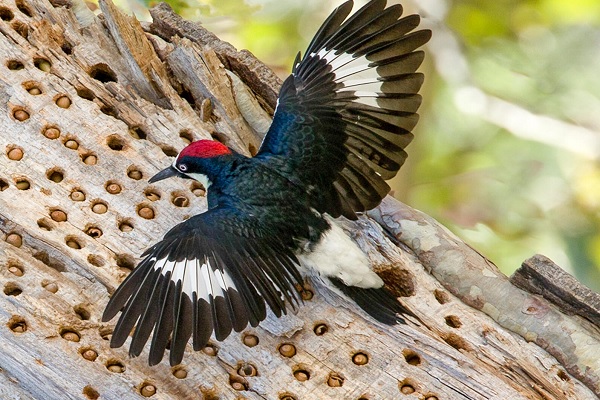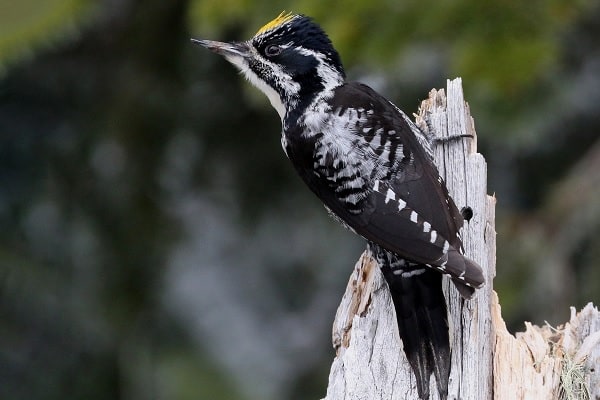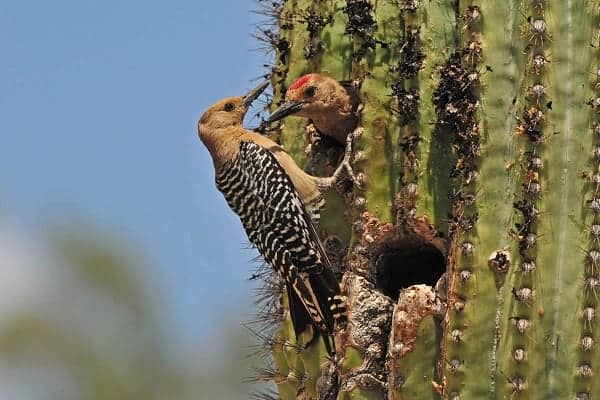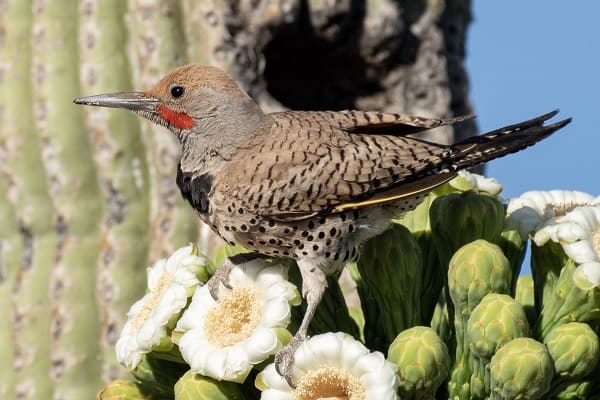Woodpeckers in Arizona are fascinating birds with diverse features and habits. In this guide, I will show you seven species that live in the state. You will learn how to recognize them by their appearance and behavior. You will also see beautiful photos of each bird. This guide is for anyone who is curious about woodpeckers and nature. Let’s discover the amazing world of woodpeckers in Arizona.
Here are the main points:
- Arizona is home to 12 different woodpecker species.
- Each woodpecker species in Arizona has distinct characteristics and behaviors.
- By learning to identify woodpeckers in Arizona, you can deepen your appreciation for these fascinating birds.
- Pictures can help you visualize the unique features of each woodpecker species.
- Exploring the habits and habitats of woodpeckers in Arizona provides insights into their ecological role.
1. Acorn Woodpecker
The Acorn Woodpecker is a distinct species found in Arizona. With its vibrant plumage and unique behaviors, this charismatic bird is a favorite among birdwatchers and nature enthusiasts alike.

The distinct characteristics of the Acorn Woodpecker make it easily recognizable. It has a bold black and white patterned plumage with a red crown on its head. The bright colors make it an eye-catching species in the woodpecker family. The Acorn Woodpecker is known for its acrobatic abilities, often seen clinging to tree trunks or hopping from branch to branch.
Habitat preferences play a significant role in the Acorn Woodpecker’s distribution. These woodpeckers are commonly found in oak woodlands and coniferous forests across Arizona. They thrive in areas with extensive tree cover, as they rely on trees for nesting and for storing their primary food source – acorns.
Acorns are a staple in the diet of Acorn Woodpeckers, which is where they get their name. They have a remarkable behavior of storing acorns in granaries or “acorn trees.” These granaries are created by drilling holes in tree trunks and filling them with acorns. The stored acorns serve as a vital food supply during winter months when other food sources are scarce.
Fun Fact:
The Acorn Woodpecker is known for its communal living habits. Several individuals, often from the same family, may live together in a single tree or group of adjacent trees, forming a complex social structure within their community.
The Acorn Woodpecker’s distinctive features, habitat preferences, and feeding habits make it a fascinating species to observe in the diverse woodpecker population of Arizona.
| Characteristics | Habitat | Feeding Habits |
|---|---|---|
| Distinct black and white plumage with a red crown on the head | Oak woodlands and coniferous forests | Primary food source – acorns |
| Acrobatic abilities, often seen clinging to tree trunks or hopping from branch to branch | Creates granaries in tree trunks to store acorns for winter |
2. Red-Naped Sapsucker
The Red-Naped Sapsucker is an intriguing woodpecker species found in Arizona. Known for its unique markings and behavior, the Red-Naped Sapsucker is a fascinating bird to observe in the wild.

This species gets its name from the distinctive red patch on the nape of its neck. The combination of black, white, and red feathers creates a striking appearance that sets it apart from other woodpeckers in Arizona. The male Red-Naped Sapsucker has a red throat patch as well, adding to its vibrant coloring.
One of the most interesting behaviors of the Red-Naped Sapsucker is its habit of drilling small holes in trees to create wells. These wells serve as a source of sap, which the bird feeds on. The sapsucker then returns to these wells to feed on the sap and the insects that are attracted to it. This unique foraging strategy sets the Red-Naped Sapsucker apart from other woodpeckers.
The Red-Naped Sapsucker prefers mixed coniferous and deciduous forests as its habitat. These woodlands provide the necessary trees for nesting and drilling wells, as well as a diverse range of insect species for food. Look for this distinctive woodpecker species in the mountainous regions of Arizona where these forests can be found.
To help identify the Red-Naped Sapsucker, refer to the following characteristics:
- Distinctive red patch on the nape of the neck
- Males also have a red throat patch
- Black and white plumage
- Medium-sized woodpecker, measuring about 8-9 inches in length
The Red-Naped Sapsucker is a unique and captivating woodpecker species that adds to the rich diversity of birdlife in Arizona. Take the opportunity to observe and appreciate this fascinating creature in its natural habitat.
Woodpeckers Found in Arizona
| Species | Characteristics | Habitat |
|---|---|---|
| Acorn Woodpecker | Distinctive red cap; communal nesting sites | Oak woodlands and forests |
| Red-Naped Sapsucker | Red patch on nape; black and white plumage | Mixed coniferous and deciduous forests |
| Downy Woodpecker | Black and white plumage; small size | Various forest types and wooded areas |
| Ladder-Backed Woodpecker | Black and white ladder-like markings on back | Desert scrublands and woodlands |
| Hairy Woodpecker | Large size; white undersides; long bill | Coniferous and mixed forests |
| Northern Flicker | Red patch on nape; barred undersides | Various open habitats including grasslands and forests |
3. Downy Woodpecker
Discover the fascinating world of the Downy Woodpecker, a small but striking species found in the diverse landscapes of Arizona. As a woodpecker enthusiast, you’ll be captivated by its unique characteristics and behaviors.
The Downy Woodpecker (Picoides pubescens) is both the smallest and most common woodpecker species in North America. It measures around 6-7 inches in length and weighs only about 1 ounce. Despite its small size, this remarkable bird boasts a beautiful black and white plumage, with vibrant white undersides and distinctive black barring on its wings.
This woodpecker species has a widespread distribution throughout Arizona, making it a delightful sight for birdwatchers across the state. The Downy Woodpecker prefers a variety of habitats, including deciduous forests, open woodlands, and backyard gardens. Keep your eyes peeled for this charming bird as it hops along tree trunks and branches in search of its favorite food.
The Downy Woodpeckers in arizona has a primarily insectivorous diet, feeding on a variety of insects, their larvae, and eggs. However, it also enjoys indulging in other food sources, such as berries, seeds, and sap. This adaptability in diet contributes to its ability to thrive in different ecosystems within Arizona.
Fun Fact: Despite its similar appearance to the larger Hairy Woodpecker, the Downy Woodpecker can be easily distinguished by its smaller bill and the black spots on its outer tail feathers.
To help you visualize the Downy Woodpecker’s characteristics, here is a table summarizing its key features:
| Size | 6-7 inches in length |
|---|---|
| Weight | About 1 ounce |
| Plumage | Black and white with vibrant white undersides and black barring on wings |
| Habitat | Deciduous forests, open woodlands, and backyard gardens |
| Diet | Insects, larvae, eggs, berries, seeds, sap |
Immerse yourself in the wonder of the Downy Woodpecker as you observe its unique behaviors and appreciate its natural beauty in the diverse landscapes of Arizona.
You might be interested to read about:-
4. Ladder-Backed Woodpecker
The Ladder-Backed Woodpecker is a fascinating woodpecker species that calls Arizona home. Known for its distinctive ladder-like markings on its black and white back, this woodpecker is a sight to behold.

The Ladder-Backed Woodpecker can be found in arid habitats such as desert scrub and oak woodlands, making Arizona an ideal location for them. They are commonly seen in southern parts of the state, where they can be observed drumming on tree trunks and foraging for insects.
One interesting behavior of the Ladder-Backed Woodpecker is its preference for cacti as nesting sites. They excavate cavities in the saguaro cactus, providing a safe and unique home for their young.
“The distinctive markings of the Ladder-Backed Woodpecker make it a true beauty among woodpecker species,” says renowned ornithologist Dr. Jane Wilson. “Its presence in Arizona adds to the rich diversity of woodpeckers found in the state.”
The Ladder-Backed Woodpecker is known to have a distinctive call, which is a short, sharp, high-pitched “pik” sound.
| Common Name | Scientific Name | Habitat |
|---|---|---|
| Ladder-Backed Woodpecker | Picoides scalaris | Arid habitats, desert scrub, oak woodlands |
With its unique features and behaviors, the Ladder-Backed Woodpecker is a true icon of the woodpecker family. Its presence in Arizona adds to the state’s rich avian diversity and offers birdwatchers and nature enthusiasts an opportunity to observe and appreciate this captivating species.
5. Hairy Woodpecker
Discover the fascinating characteristics and habits of the Hairy Woodpecker, a common resident of Arizona. This woodpecker species, scientifically known as Picoides villosus, is a beloved sight for birdwatchers and nature enthusiasts alike in the state.

The Hairy Woodpecker is a medium-sized woodpecker, measuring around 9-10 inches in length. It has a black and white patterned plumage, with a distinctive white undersurface and a black upper surface. The males and females have similar appearances, making it difficult to differentiate between the sexes.
This woodpecker is known for its strong and powerful drumming sounds. It uses its chisel-like bill to excavate nest cavities in dead or decaying trees, a behavior that aids in territory defense and attracting potential mates.
The Hairy Woodpecker primarily feeds on insects and larvae found in tree trunks and branches. It has a long, barbed tongue that it can extend to extract prey from deep crevices. Occasionally, it also feeds on seeds and berries.
When it comes to habitat preferences, the Hairy Woodpecker is commonly found in mature deciduous and mixed forests, as well as wooded suburban areas. It tends to avoid coniferous forests. In Arizona, it can be spotted in various regions, including the high-elevation pine forests and mountainous areas.
While the Hairy Woodpecker may have a similar appearance to the Downy Woodpecker, a smaller species, there are key differences to distinguish them. The Hairy Woodpecker has a larger bill, a longer overall length, and lacks the black spots on its white outer tail feathers that the Downy Woodpecker possesses.
Interesting facts about the Hairy Woodpecker:
- The Hairy Woodpecker is known to stash food items such as insects and nuts in tree crevices or bark for later consumption. This behavior is often observed during the winter months when finding food becomes more challenging.
- Unlike many other woodpecker species, the Hairy Woodpecker doesn’t migrate and remains in its preferred habitat year-round.
- In addition to drumming sounds, the Hairy Woodpecker also produces a variety of vocalizations, including sharp calls and soft, high-pitched notes.
“The Hairy Woodpecker is a charming and important part of Arizona’s avian diversity. Its presence in the state’s forests and woodlands adds beauty and excitement to any outdoor adventure.” – Jane Thompson, Birdwatching Expert
| Common Name | Scientific Name | Size | Preferred Habitat | Primary Diet |
|---|---|---|---|---|
| Hairy Woodpecker | Picoides villosus | 9-10 inches | Mature deciduous and mixed forests, wooded suburban areas | Insects, larvae, occasional seeds and berries |
6. Northern Flicker
The Northern Flicker is a recognizable woodpecker species found in Arizona. With its unique appearance and interesting behaviors, it is a fascinating bird to observe.

The Northern Flicker is a medium-sized woodpecker with a distinct plumage. Its body is predominantly brown, with black bars, spots, and patches on its wings, back, and tail. The male Northern Flicker can be identified by a black mustache-like mark on its face. Another distinctive feature is the vibrant red patch on the back of its head, which is conspicuous when the bird is in flight.
This woodpecker species is known for its distinctive call, which is both loud and unique. The call of the Northern Flicker resembles a loud “wick-a-wick-a-wick” or a “wick-a-chew” sound, often heard during their territorial displays or mating rituals.
The Northern Flicker is an adaptable species that can be found in a variety of habitats, including forests, woodlands, and urban areas. Additionally, it has a diverse diet, consisting of insects, ants, beetles, and occasionally berries and seeds.
These woodpeckers are known for their drumming behavior, which involves rapidly pecking on tree trunks or other resonant surfaces. Drumming serves various purposes, including territorial advertisement and courtship displays.
If you are lucky enough to spot a Northern Flicker in Arizona, take a moment to appreciate its distinctive appearance and observe its interesting behaviors. These birds are truly a remarkable addition to the woodpecker species that call Arizona home.
7. American Three-Toed Woodpecker

Arizona is home to a variety of woodpecker species, each with its unique characteristics. One such fascinating species is the American Three-Toed Woodpecker. Found in certain regions of Arizona, this woodpecker stands out from the rest with its distinctive features and behaviors.
Distinctive Features
- The American Three-Toed Woodpecker is easily recognized by its black and white plumage.
- It has a black head with white stripes on its face, giving it a striking appearance.
- As the name suggests, this woodpecker has three toes, unlike most woodpecker species that have four toes.
Habitat and Behavior
The American Three-Toed Woodpecker can be found in coniferous forests of Arizona. Its preferred habitats include pine, spruce, and fir trees. This species has a unique foraging technique. Instead of drumming on trees like other woodpeckers, it feeds by peeling bark off the trees to find insects underneath.
“The American Three-Toed Woodpecker exhibits a remarkable adaptation to its environment, relying on its specialized foraging behavior to find food in the coniferous forests of Arizona.” – Insert Woodpecker Expert Name
This woodpecker is known for its solitary nature, often observed searching for food alone in its preferred habitats. While its call is not particularly melodious, it adds to the ambiance of the forest.
Conservation Status
The American Three-Toed Woodpecker is considered a species of least concern on the IUCN Red List. However, habitat loss due to deforestation poses a threat to its population. Conservation efforts, including the preservation of old-growth forests, are crucial in ensuring the long-term survival of this unique species.
| Characteristics | American Three-Toed Woodpecker |
|---|---|
| Scientific Name | Picoides dorsalis |
| Size | 9-10 inches (23-25 cm) |
| Weight | 2.5-3.5 ounces (70-100 grams) |
| Habitat | Coniferous forests |
| Range | Mountainous regions of western North America, including certain areas of Arizona |
| Diet | Insects, particularly wood-boring beetle larvae found beneath tree bark |
| Conservation Status | Least Concern |
8. Gila Woodpecker
Explore the fascinating Gila Woodpecker, a desert-dwelling species that is native to Arizona. Known for its unique adaptations and striking appearance, this woodpecker has carved out a special niche in the arid landscapes of the Southwest.

The Gila Woodpecker (Melanerpes uropygialis) is a medium-sized woodpecker species that can be found throughout the Sonoran Desert region of Arizona. Named after the Gila River, its preferred habitat includes desert scrublands, saguaro cacti forests, and mesquite trees.
This woodpecker is easily recognizable by its bold black and white plumage, with a distinctive red cap on the head of the male. Unlike other woodpecker species, the Gila Woodpecker lacks the prominent red or yellow markings commonly seen on their heads. Instead, it showcases a vibrant red patch on its crown.
The Gila Woodpecker is well-adapted to its arid environment. It has a long, slightly curved beak that allows it to reach deep into cacti and trees to extract insects, sap, and fruits. These birds have also been known to excavate cavities in saguaro cacti for nesting sites, providing a valuable ecological service by creating habitat for other desert-dwelling species.
| Gila Woodpecker | Features | Habitat | Food |
|---|---|---|---|
| Appearance | Bold black and white plumage with a red cap on the head of the male | Desert scrublands, saguaro cacti forests, and mesquite trees | Insects, sap, fruits, and seeds |
These woodpeckers are social birds and can often be seen in small groups, especially during the breeding season. They communicate through a series of calls, including a distinctive “wick-a-wick-a-wick” sound.
By understanding the unique features and habitat preferences of the Gila Woodpecker, bird enthusiasts and nature lovers can better appreciate and protect this iconic species. Its presence serves as a reminder of the rich biodiversity found in the deserts of Arizona and the importance of conservation efforts to preserve these fragile ecosystems.
9. Williamson’s Sapsucker
Immerse yourself in the captivating world of the Williamson’s Sapsucker, a migratory woodpecker species that graces the landscapes of Arizona during certain seasons. With its unique behaviors and striking markings, this woodpecker is a true delight for bird enthusiasts.

The Williamson’s Sapsucker, scientifically known as Sphyrapicus thyroideus, is named after Robert Stockton Williamson, a surveyor and engineer who explored the American West in the 19th century. This beautiful woodpecker can be found in various habitats across the western United States, including the mountainous regions of Arizona.
What sets the Williamson’s Sapsucker apart is its distinct plumage, primarily consisting of black, white, and vibrant red. The male sports a black head, back, and breast, while its wings are adorned with a combination of black and white. The female, on the other hand, has a more subdued appearance, with grayish-brown feathers and white undersides.
When it comes to behavior, the Williamson’s Sapsucker is known for its preference for mature coniferous forests, where it excavates nesting cavities in dead or dying trees. It primarily feeds on sap, using its specialized tongue to lap up the sweet sustenance from sap wells created in the bark. Additionally, it also consumes insects and their larvae, ensuring a well-rounded diet.
For birdwatchers in Arizona, the arrival of the Williamson’s Sapsucker is eagerly anticipated. This woodpecker’s seasonal presence in the state provides a unique opportunity to observe its vibrant plumage and observe its fascinating behaviors.
To help you distinguish the Williamson’s Sapsucker from other woodpecker species, here’s a quick comparison:
| Species | Distinctive Features |
|---|---|
| Williamson’s Sapsucker | Black head, back, and breast; black and white wing pattern; vibrant red throat and belly |
| Acorn Woodpecker | Black back and crown; white forehead; distinct facial pattern with red, white, and black markings |
| Red-Naped Sapsucker | Black and white back; red nape and throat; white belly |
If you’re lucky enough to spot a Williamson’s Sapsucker during your time in Arizona, take a moment to appreciate its unique beauty and observe its enchanting behaviors. Remember to capture the moment with your camera and share your sightings with fellow bird enthusiasts.
10. Gilded Flicker

The Gilded Flicker is a vibrant and striking woodpecker that can be found in Arizona. With its stunning appearance and fascinating habits, this species is a true delight for bird enthusiasts.
Appearance
The Gilded Flicker stands out with its bold and eye-catching plumage. The male features a golden-yellow head and underparts, with a black crescent on its breast. Its back, wings, and tail display a beautiful black and white pattern. The female, while similar in appearance, lacks the black crescent on its breast and has a grayish head.
Habitat and Range
The Gilded Flicker prefers open desert habitats, including desert grasslands, scrublands, and saguaro cactus forests. Its range extends across the southwestern United States and into Mexico. In Arizona, these woodpeckers can be commonly found in Sonoran Desert regions.
Behavior and Feeding
Gilded Flickers are primarily insectivorous, feeding on ants, beetles, and other arthropods found in trees and on the ground. They also consume fruits and berries, especially during the winter months when insects become scarce. These woodpeckers are known for their distinctive drumming and call, which can often be heard during courtship displays.
Did You Know? The Gilded Flicker is known for its ability to excavate nest cavities, which are often reused in subsequent breeding seasons by other bird species, such as owls and kestrels.
Conservation
The Gilded Flicker is considered a species of least concern by the International Union for Conservation of Nature (IUCN). However, habitat loss and fragmentation pose threats to their population. Conservation efforts focused on protecting their preferred desert habitats are crucial to ensure the future survival of this stunning woodpecker.
11. Lewis’s Woodpecker
Discover the distinctive and captivating Lewis’s Woodpecker, a rare and unique species that can be found in specific areas of Arizona. With its striking appearance and fascinating behaviors, this woodpecker is a true gem for bird enthusiasts.

Lewis’s Woodpecker is known for its beautiful plumage, which features a mix of rich greens, purples, and reds. Its metallic-like feathers make it a standout among other woodpecker species. This bird’s elegant flight patterns and acrobatic foraging methods will leave you in awe.
In Arizona, Lewis’s Woodpecker can be spotted in areas of mixed coniferous and deciduous forests, particularly near streams or bodies of water. They prefer expansive open spaces with enough trees for nesting and perching. Feeding primarily on insects and occasionally fruits or nuts, these woodpeckers play a vital role in maintaining ecological balance in their habitat.
If you’re lucky enough to catch a glimpse of Lewis’s Woodpecker in the wild, take a moment to appreciate its unique beauty and observe its graceful movements. Remember, this species is quite rare, so any encounter is a special and memorable experience. Keep your eyes and ears open for the enchanting presence of Lewis’s Woodpecker during your next birding adventure in Arizona.
Frequently Asked Questions
Q1: What do Arizona woodpeckers eat?
Arizona woodpeckers typically eat a diet consisting of insects, larvae, ants, beetles, and occasionally fruits and nuts.
Q2: What do Arizona woodpeckers look like?
Arizona is home to various woodpecker species, including the Gila Woodpecker and the Arizona Woodpecker. The Gila Woodpecker has a distinctive black and white barred pattern on its back, while the Arizona Woodpecker has a more muted brown and black plumage.
Q3: Do Arizona woodpeckers migrate?
Woodpecker migration habits vary, but some species in Arizona, like the Gila Woodpecker, are generally non-migratory, staying in the region year-round.
Q4: What does an Arizona woodpecker sound like?
The sounds of Arizona woodpeckers vary by species. For example, the Gila Woodpecker is known for a series of rattling calls and drumming sounds, while the Arizona Woodpecker may produce a softer tapping or drumming noise.
